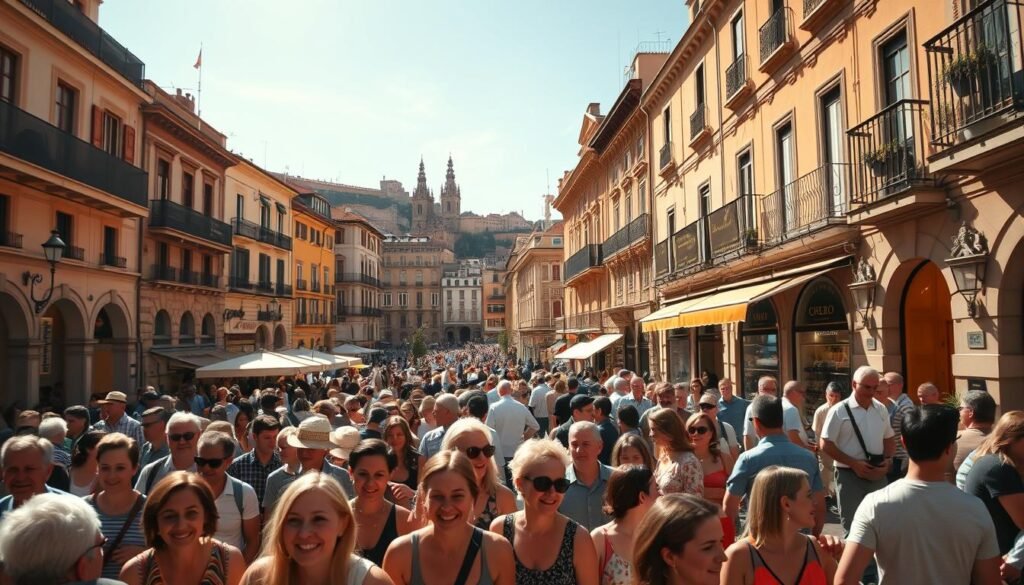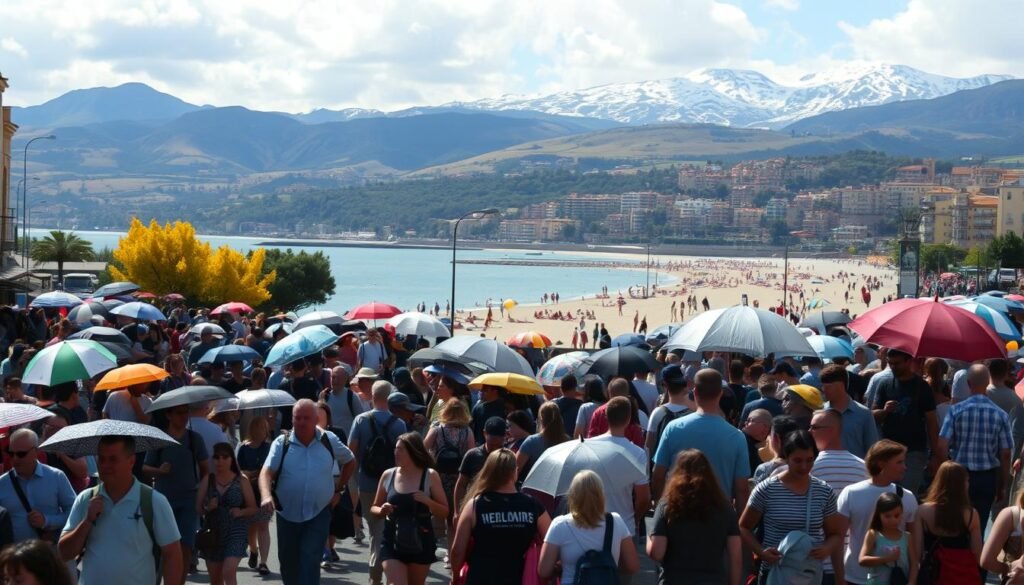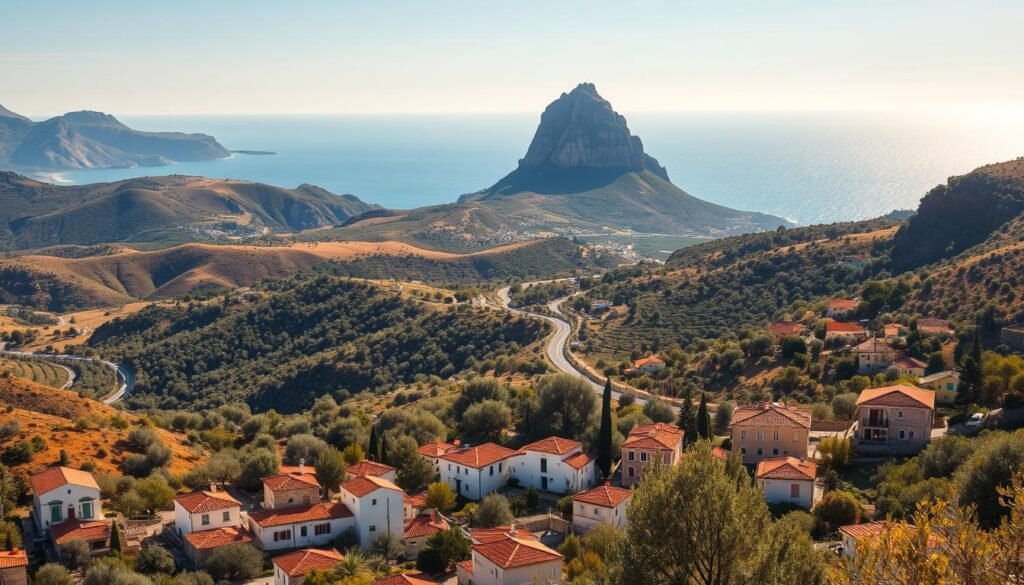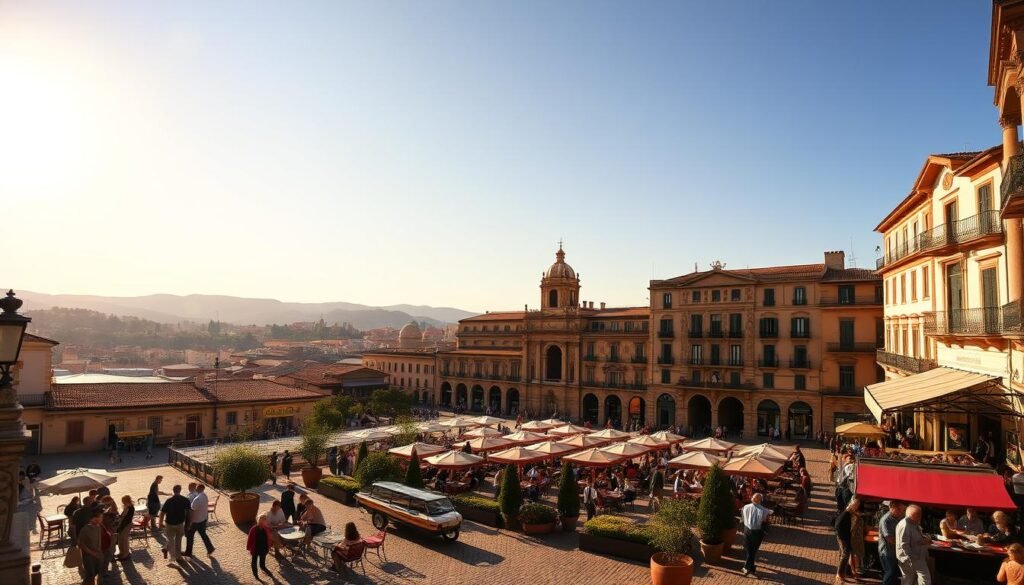Nearly 75% of Spain’s annual visitors arrive between June and August, which tells you how much the high season changes the feel of the country.
I define the best time to visit spain by balancing comfort, value, and real experiences so your trip feels effortless from landing to the last tapa.
Spain’s calendar splits into high season (June–August), shoulder months (March–May, September–October), and low season (November–February).
Late April–May and early September shine for mild weather and fewer crowds. Andalusia can hit the mid-90s in July–August, while northern regions sometimes climb into the 90s during heat waves.
Winter brings quieter streets and skiing in the Pyrenees and Sierra Nevada. The Canary Islands stay mild year-round, making them a reliable warm option if your schedule is fixed.
Key Takeaways
- I balance comfort, cost, and experiences when I recommend travel windows.
- High season runs June–August; shoulder months offer better value and weather.
- Late April–May and September are my top picks for manageable crowds.
- Andalusia gets very hot in summer; northern heat waves are possible.
- Winter suits those who prefer quiet cities and mountain snow for skiing.
- The Canary Islands provide steady warmth any month of the year.
Your quick answer: the best time to visit Spain for great weather and fewer crowds
When I plan an easy trip, my go-to windows are late April–May and September. These periods give me pleasant weather, open restaurants, and noticeably fewer crowds than summer.
Shoulder season (March–May, September–October) balances mild days with better availability and lower rates than peak months. I find bookings are easier and tours feel less rushed.
I warn travelers about Semana Santa in late March or early April; that holiday can spike crowds and prices nationwide. I also skip midsummer city breaks when possible—afternoons get sweltering unless I’m heading straight to the coast.
- Bottom line: I aim for late April–May or September for comfort and lighter foot traffic.
- Fall often undercuts spring on price, and harvest season makes wine regions especially rewarding.
- Winter brings the quietest museums and lowest hotel rates, though many beach towns scale back services.
I always check local event calendars. A single festival can change availability in a calm season, so a quick check saves surprises when I plan my trip to visit Spain.
Best time to visit Spain by season: weather, crowds, and cost

Seasons in Spain set the scene—some months bring beaches and parties, others bring quiet streets and deals. I break the year into clear windows so I can match my goals with realistic expectations.
High season (June–August)
The high season delivers long summer days, packed beaches, and lively nightlife. Expect peak prices, full hotels, and crowded icons.
When I plan for summer I book early, avoid midday heat, and accept that mornings and evenings are prime for sightseeing.
Shoulder seasons (March–May, September–October)
Shoulder season gives sun, shorter lines, and fair prices. I find spring and fall offer the best balance for walking tours and dining outdoors.
Low season (November–February)
The low season means quiet plazas, deep hotel discounts, and mountain snow for skiing. Many coastal resorts scale back services, but cities feel calmer and friendlier.
Heat and rainfall
April–May bring modest showers—useful for blooms and cooler touring days. July and August are the driest months and can bring intense heat.
I watch heat waves closely; Andalusia often reaches the mid-90s in july august and inland areas can spike into the 90s too. That nudges me toward early starts for city walks.
Festival calendar highlights
Big events shape availability: Semana Santa (late March/early April), San Fermín in July, and La Tomatina in August. I either plan around these festivals or book far ahead if I want to join them.
- High season: beaches and crowds, premium costs.
- Shoulder months: my go-to for fewer queues and nicer rates.
- Low season: best value in cities and skiing options in winter.
Beaches and islands: when to go for the Costa del Sol and the Canaries
My coastal strategy focuses on days with warm seas, plenty of sunshine, and room to relax on the sand.
Costa del Sol draws crowds in summer, and June–August is when locals flood the shore for classic beach life and lively promenades.
Costa del Sol timing
I aim for June–August when the atmosphere is electric and chiringuitos buzz. If I want fewer lines and calmer sands, I shift to September–October for warm water without the crush.
Shoulder sweet spots
Late spring and early fall give me open beach bars, warmer water, and easier parking. These windows keep the holiday vibe but remove the worst crowds.You can learn more about best-time-to-visit-alaska
Canary Islands year-round
I save the Canary Islands as a fallback when mainland weather swings too hot or too cool. Summers often sit in the upper-70s, winters rarely drop below 60°F, and daily sunshine is reliable.
| Region | Peak season | Shoulder window | Typical conditions |
|---|---|---|---|
| Costa del Sol | June–August | May–June, September–mid-October | Warm seas, busy promenades, lively beach bars |
| Mainland beaches (general) | June–August | Late spring, early fall | Good daylight, some resorts scale back in winter |
| Canary Islands | Year-round | Not applicable | Steady temperatures, abundant sunshine, mild winters |
- My rule: pick June–August for the fullest beach scene, switch to September–October for room to spread a towel.
- I structure beach days with early swims, long lunches, and sunset strolls to beat heat and crowds.
- I book coastal stays early for summer weekends and festival weeks that sell out oceanfront rooms.
For more planning tips and a broader calendar, I link a useful guide on when I choose to time visit spain.
City breaks: the best time to visit Barcelona and Madrid
![]()
I plan city breaks around months that let me enjoy museums, terraces, and easy walks without the heat or heavy crowds. A short stretch of spring or fall usually gives the best mix of weather and local life for a relaxed trip.
Barcelona: April–June and September–October
I head to Barcelona in spring or fall for 60–80°F days that let me pair Gaudí tours with a quick beach stop. Late May–June is ideal if I want a morning on the sand and afternoon sightseeing.
I also watch major draws—Primavera Sound, Sónar, and Nit de Sant Joan on June 23—so I can choose to join the festivals or avoid the surge in crowds.You can learn more about best-time-to-visit-puerto-rico
Madrid: May and September
I pick Madrid in May or September for leafy parks, tapas in sunlit plazas, and pleasant evenings that invite long walks. May’s San Isidro and the Autumn Festival in October–November are anchors for culture-driven trips if I want performances and local pageantry.
In midsummer, I schedule early or late outings to dodge the hottest hours; winter suits museum days in the Prado and cozy cafés in La Latina when the streets quiet down.
- My rule: choose spring or fall for city life that feels lived-in, not rushed.
- I book transport and dinner reservations earlier during festival times, since availability tightens fast in both cities.
- I spend neighborhood hours—from Gràcia to Malasaña—so each short city break feels local and grounded.
Month-by-month guide: Spain’s weather, crowds, and experiences

Each month brings a different mood across the country, and I plan around those shifts. Below I summarize what I look for as I pick a month for museums, walks, or wine tastings.
January–March: low season perks
January–March means quieter streets and lower hotel rates. I use this window for museum days and calm city walks.
February lights up with Carnival energy in some cities. March brings mild days and thinner lines at top sights.
April–May: festivals and prime walking weather
April centers on Semana Santa; I either join processions or pick quieter cities. Seville’s Feria de Abril follows about two weeks later.You can learn more about best-hawaiian-island-to-visit
I save May for flower-filled strolls and longer treks like the Camino de Santiago before crowds rise.
June–October: long days, heat, and harvest
June delivers long, sunny days—great for rooftops and patios. July–August bustles with beach towns and can be very hot in inland cities.
August favors the cooler north—Basque Country, Asturias, and Galicia feel more pleasant then. September–October pairs late-summer beaches with wine harvest events and calm city breaks.
| Month block | Typical draw | My tip |
|---|---|---|
| Jan–Mar | Quiet museums, low rates | Book museums and use off-peak hotel bargains |
| Apr–May | Festivals, spring blooms | Plan around Semana Santa; reserve Camino stages early |
| Jun–Oct | Long days, beaches, harvest | Shift heavy sightseeing to mornings in July–Aug; enjoy wine in Sept–Oct |
- Note: I often avoid midday sightseeing during peak summer heat and opt for early starts.
- I lean into November for serene city breaks, and December for festive markets and the 12 grapes at midnight.
- For a wider planning view, I refer to a helpful calendar when I choose the ideal month: planning resource.
Regional nuances: north vs. south, beaches vs. mountains

A single week can offer sizzling city heat in Andalusia and cool seaside afternoons in Galicia. I watch local weather and festival calendars so my route fits each region’s rhythm.
Andalusia and the south: hot summers, great spring and fall for city sightseeing
Andalusia runs hot in July–August, with highs around 96°F. I favor spring and fall for exploring Seville, Córdoba, and Granada so palaces and patios feel pleasant.
I schedule early starts and long siestas in summer. That avoids the worst midday heat and improves my chances of smooth museum visits.
Northern Spain in summer: Basque Country, Asturias, and Galicia to cool off in August
In summer I often head north. The Basque Country, Asturias, and Galicia bring green hills, Atlantic breezes, and cliff-backed beaches that soothe hot afternoons.You can learn more about best-time-to-visit-bali
Even there, heat spikes can happen, but coastal air usually moderates afternoons. I mix beach days with old-town walks in cities like San Sebastián and Bilbao.
- I time Andalusian city days for spring and fall to avoid searing midday heat.
- I shift summer trips north for milder afternoons and quieter beaches.
- I compare inland versus coastal weather so each stop matches expectations.
- I use trains and short flights to hop regions and match each stop to its seasonal sweet spot.
| Area | Typical season | Conditions | My tip |
|---|---|---|---|
| Andalusia | Spring / Fall | Very hot in summer (≈96°F) | Visit palaces early; avoid midday heat |
| Northern regions | Summer | Cooler, Atlantic breezes, green coast | Pair beach picnics with city rambles |
| Interior vs. Coast | Year-round variations | Inland hotter; coast milder | Check local events; plan shaded breaks |
I keep an eye on crowd shifts and use this approach when I plan the ideal time visit spain for a balanced, comfortable trip.
Conclusion
My final rule is simple: map your must-see list against months that favor those experiences.
I aim for late April–May or September–October for mild weather, fewer crowds, and open services. For city days I pick shoulder months; for coast I shift toward early summer or September.
I slot wine country into harvest in fall and keep museum-heavy days as backups when forecasts change. Barcelona fits late spring and early fall, while Madrid works well in May and September.
Tip: use the Canary Islands as a year-round safety net, then lock dates once your wishlist and budget align with regional seasons and prices.





















